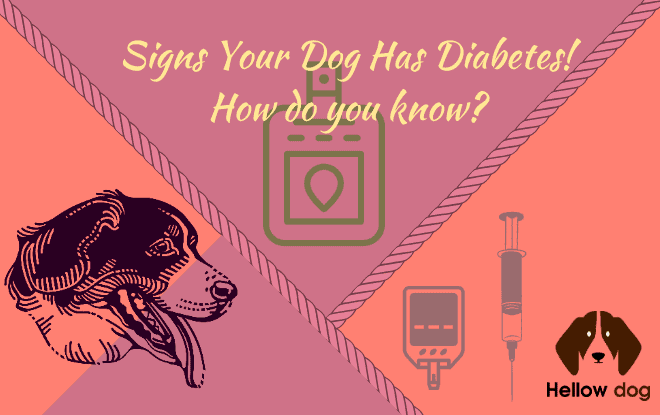Diabetes refers to an ailment of the body that happens as a result of the body’s inability to produce or utilize insulin, a fact that makes the body’s blood sugar levels rise very high. Insulin refers to a hormone that is produced in the pancreas and allows cells to take sugar (glucose) from the blood and use it to function. Like humans or other animals such as cats, dogs can also suffer from diabetes. In fact, it is estimated that approximately 1 in 500 dogs are affected by this disease. Your dog has diabetes and what are you going to do about it? Are you informed enough to take action or you like to go to a vet? This article gives you insight so that you don’t get panicked.
What is Dog Diabetes?
Diabetes in dogs or simply canine diabetes is a chronic disease that occurs when the dog’s body does not produce enough insulin hormone, or when it produces it, but is unable to take advantage of it properly.
When a dog eats, its digestive system begins to undo foods in various components that include the glucose that is transported by the insulin hormone to the cells of the body. Once the glucose is inside the said cells, it is stored for later use as a source of energy.
When the pancreas, which is responsible for secreting the hormone of insulin does not produce this hormone or when the body’s cells do not respond correctly to that insulin is when diabetes occurs. Therefore, diabetes in dogs could be classified into two types;
Type I: It is the most common in dogs and occurs when there is a shortage of insulin in the body. Type 1 diabetes, also known as diabetes mellitus, is the most severe form of the disease since the animal will depend on the daily intake of insulin injections to maintain the balance of blood sugar.
Type II: Caused by an incorrect response of the body to the insulin which is being produced. Type 2 diabetes is found mostly in cats and people, so it is unusual for dogs to be affected.
Both types of canine diabetes, cause the muscles and internal organs cannot convert glucose into energy, resulting in excess glucose in the blood is also known as hyperglycemia.
[tcb-script async=”” src=”https://pagead2.googlesyndication.com/pagead/js/adsbygoogle.js”][/tcb-script][tcb-script] (adsbygoogle = window.adsbygoogle || []).push({});[/tcb-script]
Video of Understanding Dog Diabetes Part 1 & 2 Symptoms and Diagnosis
Signs Your Dog Has Diabetes
When a dog suffers from diabetes, its appetite is much greater since it’s not able to transform the glucose into energy, and the brain cannot perceive that it is receiving food.
Diabetes can exist for a while before it starts to make an animal obviously sick. The glucose in the urine causes the diabetic dog to expel large volumes of urine. In turn, this produces dehydration and the need to drink large amounts of water.
Initially, dogs that do not metabolize enough sugar have an increase in appetite and the desire to eat more. Later, due to the effects of malnutrition, the appetite decreases.These are the signs your dog has diabetes.
Signs your dog has diabetes may vary depending on the stage of the disease, but may include the following:
• Increased water consumption
• Excessive urination
• Urinary accidents in the house
• Weight loss
• Vomiting
• Dehydration
• Lethargy (tiredness)
• Increase or decrease in appetite
• Bad breath (fruity smell)
[tcb-script async=”” src=”https://pagead2.googlesyndication.com/pagead/js/adsbygoogle.js”][/tcb-script][tcb-script] (adsbygoogle = window.adsbygoogle || []).push({});[/tcb-script]
How to Test a Dog for Diabetes at Home
Diabetes is a serious disease and manifests itself when the body produces insufficient insulin or sometimes it does not. Like humans, dogs can get diabetes, and if they do, they should be treated properly. Monitoring diabetes in dogs can be challenging because they cannot tell their symptoms. However, you can monitor canine diabetes if you are aware of the signs of diabetes and have the right equipment at hand. This can be handled through the following steps:
1. In-House Blood Glucose Testing
In-house blood glucose testing is an effective process as regards detecting a dog with diabetes. This can also be a tricky task to complete as many external factors influence a dog’s blood glucose levels. Stress, heat, exercise, eating habits, diseases and normal daily actions are all events that can affect blood glucose levels. This constant balance in numbers can make the home blood test very difficult because you will need to keep a continuous watch on the physical indications of high or low blood sugar as well. In testing a dog’s blood glucose at home, meters have also proved to be effective.
At home, monitors for portable blood glucose tests are often referred to as meters or glymeters. Using a meter at home with your diabetic dog may be an easier and cheaper method for monitoring your pet’s blood sugar. Meters for testing are made by various manufacturers, such as Accu-Check, One Touch, and Free Style. These companies also produce test strips that gather a small drop of blood at the tip of the strip, which is then read by the machine and translated into a number. This number is the blood glucose level and is measured per mg / dL. Test methods used in detecting your dog’s blood glucose to monitor its diabetes can be quite complicated as well. Depending on your dog’s tolerance for pain and their behavior during the test, gathering a drop of blood can be simple or an event. Usually, the method of testing your dog’s glucose levels is the first to use a lancet device to collect a drop of blood from any of its ear, tail, lips or paw. The location of the blood sample will depend on what your dog will allow. A test strip is then inserted into the meter, and then it will collect the drop of blood, allowing the end of the test strip to suck the blood through its tip. The meter will then read the glucose level in about five seconds and inform you of your dog’s diabetes status.
2. In-House Urine Testing
This involves collecting the dog’s urine and testing it to monitor its glucose levels. Furthermore, in-house urine testing is non-invasive, does not cause discomfort to your pet and you can also get the result of ketones and proteins as well as glucose in a simple test. To do this, go through the following steps:
1. Take your dog for a walk
2. Have a clean container prepared to catch urine.
3. Take a urine rod supplied by your veterinarian and immerse it in the urine.
4. Following the instructions on the packaging, wait for the specified amount of time, and then hold the end of the stick next to the chart provided on the package to compare colors. The colors will show whether your pet’s urine is normal or not.
[tcb-script async=”” src=”https://pagead2.googlesyndication.com/pagead/js/adsbygoogle.js”][/tcb-script][tcb-script] (adsbygoogle = window.adsbygoogle || []).push({});[/tcb-script]
Your Dog is at Risk of Diabetes- What are the Problems?
In both people and animals, diabetes is a disease that occurs when the body cannot produce or use insulin, which is the hormone responsible for transmitting glucose to cells to convert it into energy. This factor determines if there are high levels of blood sugar.
Although there are different types of diabetes, dogs usually suffer from the so-called type 1. It is the one that develops when the pancreas does not generate enough insulin.
This condition, if not treated in time, can have consequences for dogs. For example:
• Urinary tract infections
• Inflammation of the pancreas
• Renal disease
• Cushing’s disease
• Coronary problems
• Anemia
• Thyroid problems
Although many think that this is a more common disease in elderly animals, diabetes in dogs can occur at any age. In any case, the largest number of cases occur between 7 and 9 years of age of the dog.
However, other factors imply an increased risk of developing this disease. For example:
• Obesity
• Females that have not been castrated
• Genetic inheritance
How to Prevent Diabetes in Dogs?
Most of the measures to take to reduce the risks are quite simple. And as in humans, they respond to the most elementary norms of common sense.
Respect the nutritional needs of dogs. Avoid dog diabetes; it is not enough to suppress sweets and sugars from your diet. These pets need to ingest high doses of proteins from live animals. It should never be overlooked that in essence, they are carnivorous animals.
Sometimes there is no time or the means to acquire natural foods of animal origin. The selection of packaged foods must obey the following parameters:
The package should read “made with fresh meat” or “made with chicken thigh.” This implies that the formula has been developed from there. On the contrary, foods that claim to be made with meat or chicken “to dry,” do not guarantee the quality of the base ingredient. In fact, it is a most likely waste (in many cases unhealthy) that are not suitable for consumption.
The same principle applies to fruits: it should be read, “fresh apples” and “whole.”
Dogs do not require cereals in their diet. Good food for dogs can have a minimum portion of this component. Diabetic dog treats, be they homemade or shop-bought can greatly contribute to the energy of a dog and prevent the onset of diabetes as well.
Some great Diabetic dog treats include Cookies oatmeal; meat flavored dog cookies and dog cheese biscuits.
Avoid diabetes in dogs; these pets also require a routine of daily physical activities and exercises. It’s not just about taking them out on a couple of streets twice a day to meet their physiological needs.
Although the demand for physical exercise of each dog varies according to the needs of each race, all dogs, like their masters, burn excess glucose and fat while running and playing.
Conclusion
Diabetes in dogs is caused by the lack or uselessness of insulin, the hormone responsible for controlling blood glucose as highlighted above. Moreover signs your dog has diabetes are visible enough.
In addition, having a dog diagnosed with diabetes can seem overwhelming, but just like people with diabetes, your dog can live a full life. One of the concerns for pet owners is what will be dog diabetes cost. The initial costs of getting the dog stabilized can quickly add up to several hundred dollars, but once the glucose levels are in the normal range, the current monthly maintenance costs will be less.
In case there is a need to proceed with insulin or any tests for the treatment of the disease, prices are as follows: Stabilizing the dog’s health will have at least a cost of $ 100. To treat diabetes in dogs, insulin for humans and pigs are commonly used. Human insulin is priced at $ 67(approx.) a month, while pork insulin costs $ 49(approx.) a month.
If the dog is detected with diabetes, understand the recommended treatment. Dogs cannot express themselves as humans. Therefore, the dog owner has to be more attentive to perceive signs of the disease in his dog. In case of any suspicious signs, seek immediate help from the veterinarian and take the preventive measures most beneficial to your dog and watch him live a happy life.
Disclaimer
All information contained in this website is intended for informational purposes only, as I am not a veterinarian. Furthermore, the content of the website should not be understood as an appeal to ignore the instructions or advice that may be issued by your veterinary doctor.







